Question # 1
Fig. below shows the speed-time graph of a moving object.
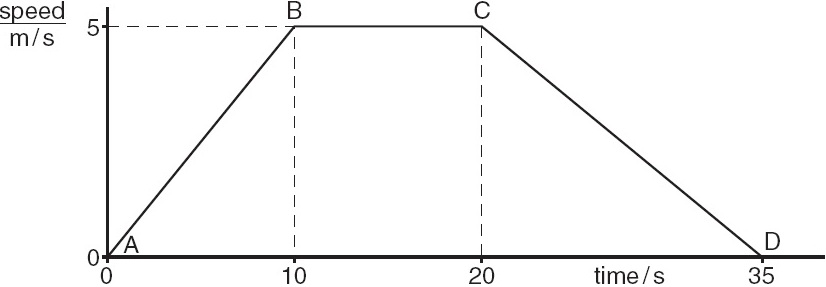
(a) Which part, or parts, of Fig. above indicate when the object is
(i) travelling at uniform speed,
(ii) accelerating?
(b) Calculate the distance travelled in the last 15 s.
Solution
(a)
(i) In the part, BC, the object is travelling at constant (uniform) speed as 5 m/s.
(ii) In the part AB, the object is accelerating as the speed is increasing.
(b) The distance travelled by the object in the last 15 s is the area
under the line CD, so the distance travelled is the area of the right
angled triangle as
| distance travelled = |
1 |
x 5 x 15 =
37.5 m |
| 2 |
Question # 2
Two girls attempt to measure the speed of the water in a river, as shown in Fig. below.
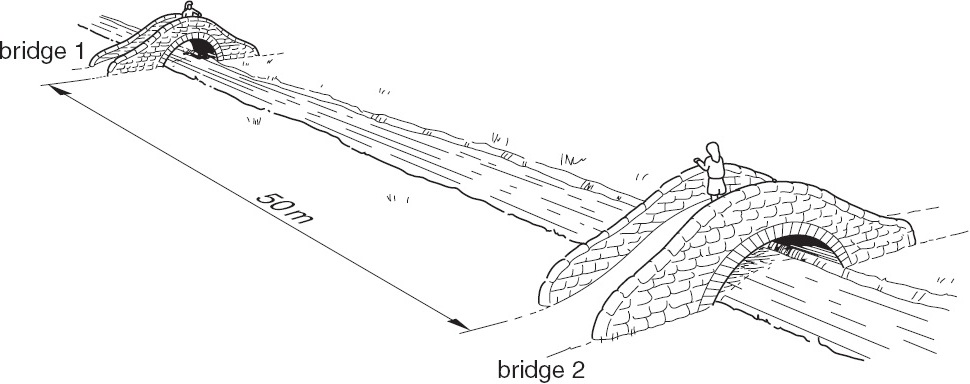
(a) The distance between the two bridges is measured as 50 m.
Suggest an appropriate instrument that they might use to measure this distance.
(b) The girl on bridge 1 drops a piece of wood into the water. The girl on bridge 2 measures how
long it takes for the piece of wood to reach bridge 2. It takes 400 s to travel between the two
bridges.
(i) Name an appropriate instrument that could be used to measure this time.
(ii) Describe the procedure for measuring this time.
(iii) Calculate the speed of the water.
Question # 3
(a) In a laboratory experiment to find the centre of mass of a triangular piece of card, the card is
suspended first from point A and then from point B, as shown in Figs. 3.1 and 3.2.
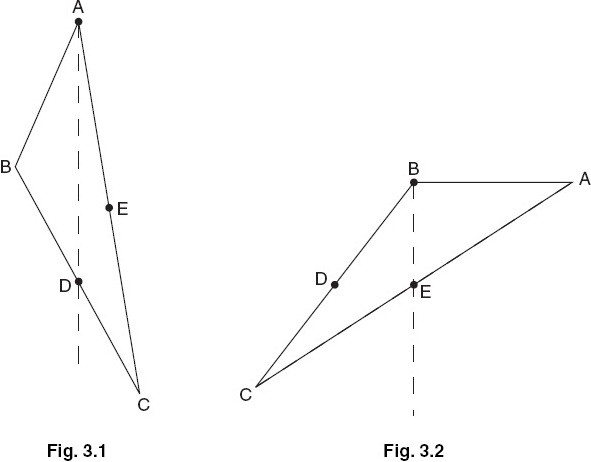
When suspended from A, point D is found to be vertically below A.
When suspended from B, point E is vertically below B.
(i) What piece of apparatus might be used to determine the vertical lines through A and B?
(ii) On Fig. 3.3 below, draw construction lines to find the position of the centre of mass of
the triangular card. Label this point clearly with the letter G.
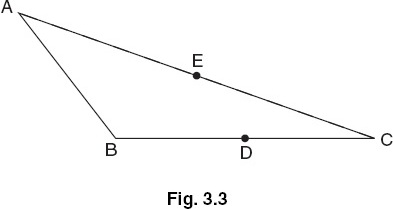
(b) Fig. 3.4 illustrates a toy that always returns to the upright position, whatever position it is put
in to start with.
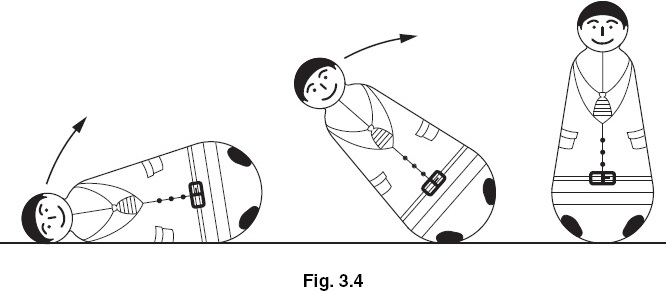
On one of the three positions of the toy shown in Fig. 4.3, clearly mark X at a possible position
for the centre of mass of the toy.
Question # 4
In Fig. 4.1, the smoke cell consists of an illuminated glass box into which some smoke has been injected.

(a) Describe briefly what is seen when the contents of the smoke cell are viewed through the focused microscope.
(b) State the name we normally give to what is seen.
(c) What deductions about the properties and behaviour of air molecules can be made from
these observations?
Question # 5
A card is held against a rotating toothed wheel, as shown in Fig. 5.1.
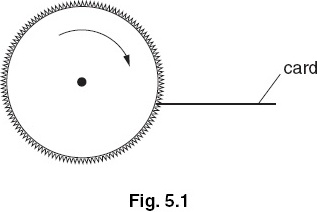
The wheel has 150 teeth and rotates 3 times per second.
(a) Calculate the frequency of the sound produced.
frequency = ................ Hz
(b) State the approximate range of frequencies that can be heard by a healthy human ear.
lowest frequency = ..................... Hz
highest frequency = .................... Hz
(c) The speed of rotation of the wheel is increased.
What happens, if anything, to the pitch of the sound that is heard?
Question # 6
The list below contains the names of the various regions of the electromagnetic spectrum, but they are in the wrong order
and an extra, non-electromagnetic type of wave motion has been included.
| infra-red radiation |
| X-rays |
| gamma rays |
| visible light |
| radio waves |
| ultrasound waves |
| ultra-violet radiation |
(a) Which one of these is not electromagnetic?
(b) (i) In the boxes below, list the various regions of the electromagnetic spectrum in order of
wavelength. The first and last boxes have been filled in for you.
(ii) Which of these has the longest wavelength?
(iii) Which of these produces a significant heating effect?
(iv) Which of these may be used to obtain a picture of a broken bone inside the body?
Question # 7
The pivoted steel arrow from a small compass has become demagnetised.
The coil shown in Fig. 7.1 is to be used to magnetise it again.
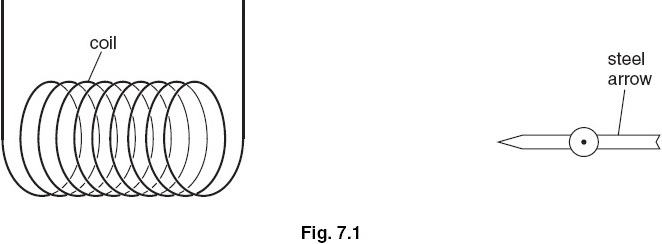
(a) Describe carefully
(i) how the coil is used to magnetise the steel arrow,
(ii) how the polarity of the magnetised needle may be checked.
(b) On Fig. 7.1, draw the magnetic field pattern of the magnetised needle.
Question # 8
A student learning about electric circuits connects up the circuit shown in Fig. 8.1.
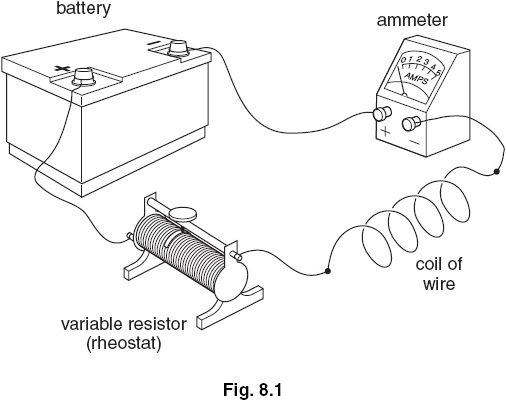
(a) The student has already made one mistake with his connections.
What is his mistake?
(b) Draw the circuit diagram of the arrangement shown in Fig. 8.1, using standard symbols.
(c) The student now connects a voltmeter to the circuit, so that readings can be taken to find the
resistance of the coil of wire. On your circuit diagram, draw the voltmeter, connected to measure the potential
difference across the coil.
(d) Having obtained a correctly-working circuit, the readings on the two meters for one setting of the variable
resistor are as shown in Figs. 8.2 and 8.3.
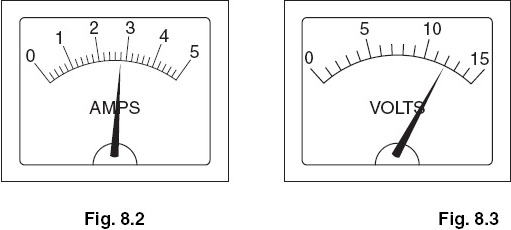
(i) Record these two readings.
ammeter reading = ......................... A
voltmeter reading = ........................ V
(ii) The slider on the variable resistor (see Fig. 8.1) is moved a small distance to the left, reducing its
resistance.
State what happens to the readings on the two meters.
ammeter reading ...............................................................................
voltmeter reading ..............................................................................
(iii) The slider is adjusted so that the total resistance in the circuit is double that which gave the readings
in Figs. 8.2 and 8.3.
Calculate the new values of the readings on the meters.
ammeter reading = ......................... A
voltmeter reading = ........................ V
Question # 9
(a) The circuit symbol shown in Fig. 9.1 represents a device often used in electrical equipment.
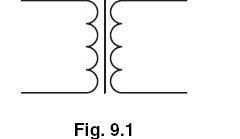
State the name of this device.
(b) Fig. 9.2 shows, in simplified form, the essential parts of a grid system for distributing electrical energy from
a power station to domestic consumers. The device in part (a) is used both at X and at Y.

(i) Using information from Fig. 9.2, deduce the ratio (secondary turns / primary turns) necessary at X and at Y.
turns ratio at X = .........................
turns ratio at Y = .........................
(ii) State two reasons why power transmission is cheaper if the voltage across the cables is very high.
Question # 10
(a) Complete the following statement about an electric field.
An electric field is a region in which ...................................
experiences a .........................
(b) Fig. 10.1 shows two identical light uncharged balls suspended on thin nylon threads.
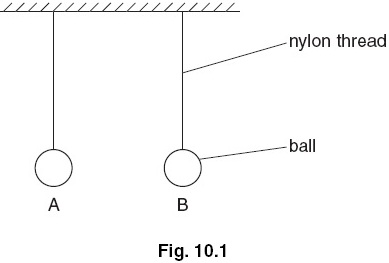
Ball A is given a positive charge and ball B is given a negative charge.
Draw a diagram showing the positions that the balls and threads will take, now
that the balls are charged.
(c) On ball B in your diagram, use labelled arrows to show the directions of
(i) the electrostatic force on the ball (label it E),
(ii) the weight of the ball (label it W),
(iii) the tension force of the thread on the ball (label it T).
(d) Ball B is in equilibrium. State the value of the resultant of forces E, W and T.
resultant = ..........................................
Question # 11
Fig. 11.1 shows a tube that can be used to produce cathode rays. Metal plates above and below
the tube have zero potential difference between them.
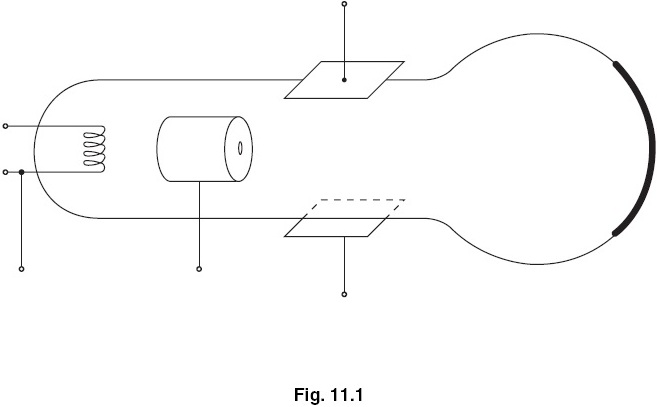
(a) On Fig. 11.1, clearly label
(i) the filament cathode (label it C),
(ii) the anode (label it A).
(b) On Fig. 11.1, draw
(i) a battery (label it B), connected to cause thermionic emission of electrons,
(ii) a 1000 V power supply (label it P), connected to cause a beam of cathode rays along the tube,
(iii) the path of the beam of cathode rays along the tube.
(c) What is seen when the beam of cathode rays hits the screen?
(d) A high potential difference is now connected between the two metal plates, so that the lower plate is
positive and the upper plate is negative.
What change is seen on the screen?
Question # 12
The count-rate from a sample of radioactive material is investigated by a team of scientists in a laboratory.
(a) With the radioactive sample in place, the count-rate from the sample is determined every 7 days, with the
results shown below. The background count-rate has already been subtracted.
| time / days | 0 | 7 | 14 | 21 | 28 |
| count-rate / (counts / s) | 1000 | 550 | 300 | 160 | 90 |
On Fig. 12.1, plot a graph of count-rate from the sample against time.

(b) (i) From your graph, find the time at which the count-rate is
1. 800 counts / s, ........................ days
2. 200 counts / s. ........................ days
(ii) From the figures in (b)(i), find the value of the half-life of the substance.
half-life = ........................ days